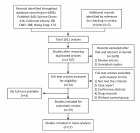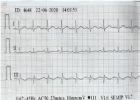Table of Contents
Influence of an integrated rehabilitative treatment on the modification of body representation in patients affected by Unilateral Spatial Neglect
Published on: 11th December, 2018
OCLC Number/Unique Identifier: 7964847360
Background: In line with the so-called “embodiment concept”, human bodily experience is characterized by the immediate feeling that our body is localized in a certain position in space and that the self is localized within these body limits.
Aim: To verify in a cohort of patients affected by unilateral spatial neglect (NSU) secondary to cerebrovascular damage the possible correlation between a comprehensive neuromotor/neuropsychological rehabilitative treatment and the modification of body representation.
Setting: A rehabilitation institute for the treatment of neurological gait disorders and neuropsychological failures.
Methods: 12 patients (7 males, 5 females; mean age 60 ± 2yy) affected by NSU secondary to cerebral stroke and recovered in the Neurological Rehabilitation Section of the Clinical Institute Città di Brescia were recruited for the aim of this study. In accordance with our inclusion criteria we recruited 4 patients affected by ischemic stroke and 8 patients affected by haemorragic stroke; 9 patients of our study group arrived from a coma state period. Recruited patients underwent at time T0 (hospitalization day) to a functional impairment evaluation (Motricity Index = MI; Trunk Control Test = TCT; Functional Ambulation Category = FAC) and to a neuropsychological evaluation (Behavioural Inattention Test = BIT; Representional drawing; Personal Neglect evaluation scale); each evaluation was repeated in the same way at time T1 (intertime between 2 and 4 months after hospitalization) and time T2 (inter time between 5 and 6 months after hospitalization). At time T0 each patient began an individualized integrated (motor and neuropsychological) rehabilitative treatment course.
Results: In all patients recruited a statistical significant modification was observed for the MI LL left, the TCT and the FAC; no significant statistical modification was observed for the MI UL left, the MI UL and the MI LL right. The t-test showed a significant statistical modification of the personal neglect evaluation scale while no significant statistical modification was defined for the spontaneous human figure drawing test proceeding from time T0 to time T1. The spontaneous drawing of the human figure showed an individual different trend and modification in all patients recruited. A correlation analysis was made comparing the mean value of all motor scales (G1) with the mean value of all neuropsychological scales (G2) and no statistical significant correlation was observed between G1 (T0) and G1 (T1), G1 (T0) and G2 (T0), G1 (T0) and G2 (T1), G2 (T0) and G1 (T1), G2 (T0) and G2 (T1), G1 (T1) and G2 (T1). A second correlation analysis was made comparing all single motor scales with the neuropsychological scales, for the group made by 12 patients and the group made by 5 patients. For the group made by 12 patients, we observed the subsequently significant correlations: MI UL left (T0) correlates with MI LL left (T0); MI LL left (T0) correlates with MI LL left (T1); MI UL left (T1) correlates with MI LL left (T1); MI LL left (T1) correlates with FAC (T1); TCT (T1) correlates with FAC (T1). For the group made by 5 patients, we observed the subsequently significant correlation: TCT (T2) correlates with FAC (T2). In the group made by 12 patients, the mean amelioration of the time related normalized (T0-T1) motor scales is equal to 49% while to 63% was observed for the neuropsychological scales. The mean amelioration of the neuropsychological scale proceeding from time T0 to T1 is equal to 26% with an increase equal to 57% proceeding from time T1 to T2. The neurocognitive amelioration can be observed especially between the 5th and 6th month from the ischemic cerebral damage with a mean increase from 26% to 57%.
Conclusions: It would certainly make sense to treat patients with NSU from the neuropsychological point of view in the long term and from the neuro-motor point of view in the first 3-4 months after stroke; in all this, we cannot exclude that an improvement of the visuo-spatial exploration, emphasized by the neuropsychological treatment, can positively influence also patient’s motor outcome.
Functional Electrical Stimulation (FES): Clinical successes and failures to date
Published on: 2nd November, 2018
OCLC Number/Unique Identifier: 7929240992
Non-invasive electrical stimulation in the form of neuromuscular electrical stimulation (NMES) and functional electrical stimulation (FES) has been documented as an optional assessment and treatment technology for decades. In contrast, translation of the robust clinical evidence supporting the effectiveness of FES’ enhancement of muscle force generation and adding to the recovery of motor control following damage to the brain appears limited. Furthermore, enabling many patients to regain locomotion ability though utilization of FES as a standard care option in rehabilitation medicine remains unmet. This perspective evolved over years of collaborative experience in clinical research, teaching, and patient care having a common goal of advancing patients’ rehabilitation outcomes. The clinical successes are supported by repeated evidence of FES utilization across the life span, from toddlers to elders, from hospitals’ critical care units to the home environment. The utilization include managing multiple deficits associated with the musculo-skeletal, neurological, cardio-pulmonary, or peripheral vascular systems. These successes were achieved in no small part because of the technological advancement leading to today’s wearable wireless FES systems that are being used throughout the continuum of rehabilitation care. However, failures to benefit from FES utilization are likewise numerous, collectively depriving most patients from using the technology to maximize their rehabilitation gains. The most critical failures are both clinical and technological. Whereas numerous barriers to NMES and FES utilization have been published, the focus of this perspective is on barriers not considered to date.

HSPI: We're glad you're here. Please click "create a new Query" if you are a new visitor to our website and need further information from us.
If you are already a member of our network and need to keep track of any developments regarding a question you have already submitted, click "take me to my Query."




















































































































































